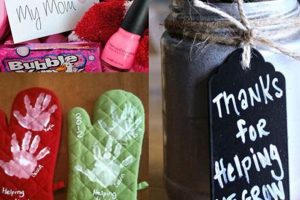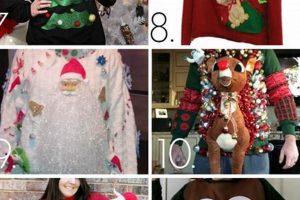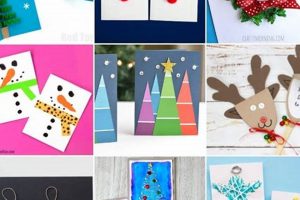Creative holiday-themed apparel can be personalized through do-it-yourself customization. This involves taking a standard sweater and embellishing it with festive decorations, transforming it into a unique garment suitable for Christmas celebrations. For example, individuals might affix felt shapes, pom-poms, or battery-operated lights to a plain sweater to create a whimsical and personalized design.
The appeal of crafting holiday-themed sweaters lies in the opportunity for self-expression, cost savings, and the creation of a memorable garment. Engaging in this activity fosters creativity and allows individuals to produce distinctive attire, avoiding mass-produced designs. Furthermore, handmade items often carry sentimental value, becoming treasured keepsakes. Historically, decorating clothing for seasonal festivities has been a tradition in many cultures, and this practice extends to contemporary holiday celebrations.
The following sections will explore various design approaches, material selection considerations, and practical tips for producing personalized holiday sweaters. These resources provide guidance for creating unique and festive apparel.
Tips for Holiday Sweater Customization
The creation of personalized holiday sweaters requires careful planning and execution. Adherence to the following guidelines can improve the quality and longevity of the finished product.
Tip 1: Design Conceptualization: Prior to material selection, sketch a detailed design. This will serve as a visual guide throughout the creation process, ensuring a cohesive and aesthetically pleasing outcome.
Tip 2: Material Selection: Choose durable and appropriate materials. Felt, fabric glue, and sturdy embellishments are recommended for their longevity and ease of application. Consider the sweater’s material when selecting adhesives to ensure proper bonding.
Tip 3: Secure Attachment: Employ robust attachment methods. For items that require frequent washing, consider sewing embellishments rather than relying solely on adhesive. Reinforce glued items with stitching for added security.
Tip 4: Balance and Symmetry: Strive for visual balance in the design. Distribute embellishments evenly across the sweater to avoid a lopsided or cluttered appearance. Consider the garment’s proportions when placing design elements.
Tip 5: Functionality and Comfort: Prioritize comfort and wearability. Avoid placing bulky or sharp embellishments in areas that will cause discomfort during wear. Ensure that the design does not restrict movement.
Tip 6: Washing Instructions: Develop clear washing instructions. Provide specific guidance on cleaning the customized sweater to maintain its integrity. Hand washing or gentle machine washing is generally recommended.
Tip 7: Quality Control: Inspect the finished product thoroughly. Examine all attachments for security and address any loose ends or imperfections before wearing or gifting the sweater.
By implementing these guidelines, creators can produce personalized holiday sweaters that are both visually appealing and durable, ensuring enjoyment for years to come.
The subsequent section will provide insights into advanced techniques and creative approaches for taking holiday sweater customization to the next level.
1. Design Conceptualization
Design conceptualization is the foundational element in the successful execution of personalized holiday sweater creation. It dictates the aesthetic outcome, influences material selection, and guides the implementation of embellishment techniques. A well-defined concept prevents haphazard application of decorations, ensuring a cohesive and visually appealing finished product. Without a clear plan, the resulting sweater can appear cluttered, unbalanced, and lacking in thematic unity. For example, a meticulously planned “winter wonderland” concept would involve a deliberate selection of white and silver embellishments, carefully arranged to evoke a sense of serenity and seasonal beauty. Conversely, a poorly conceived design might result in a jumble of unrelated festive symbols, diminishing the overall impact.
The practical significance of design conceptualization extends to resource management and efficiency. A pre-determined design allows for accurate material estimation, preventing overspending on unnecessary supplies. It also facilitates a streamlined creation process, minimizing errors and rework. Consider the scenario where an individual intends to create a sweater featuring a specific cartoon character. Thoroughly sketching the character’s features and proportions beforehand ensures that the felt cutouts are appropriately sized and positioned, reducing the likelihood of mistakes that would require additional materials and time to correct.
In summary, design conceptualization is not merely an optional preliminary step, but a critical prerequisite for crafting personalized holiday sweaters that are both aesthetically pleasing and cost-effective. While challenges may arise in translating initial ideas into tangible designs, the benefits of a well-defined concept far outweigh the effort invested. A robust understanding of this connection links directly to the success and enjoyment derived from the overall creative endeavor.
2. Material Selection
Material selection is a pivotal determinant in the success of personalized holiday sweater projects. The properties of chosen materials directly influence the aesthetic appeal, durability, and comfort of the finished garment. Inappropriate choices can lead to premature degradation, compromised visual impact, and decreased wearability.
- Base Garment Suitability
The foundation of any embellished sweater lies in the choice of the base garment. Considerations include fiber content, weight, and color. Natural fibers, such as wool or cotton, offer breathability and comfort, but may require specific care during embellishment. Synthetic blends provide durability and resistance to shrinkage. The weight of the sweater should be appropriate for the climate in which it will be worn. A dark-colored sweater provides a versatile backdrop for various embellishment styles, while lighter colors may require consideration of potential bleed-through from adhesives or dyes.
- Embellishment Medium Compatibility
Selecting embellishments that are compatible with the base garment is critical. Felt, sequins, pom-poms, and fabric paint are commonly used, but their adhesion and colorfastness must be assessed. Fabric glue should be chosen based on the fiber content of both the embellishment and the sweater to ensure a secure bond. When using heat-activated materials, such as iron-on transfers, the heat tolerance of the sweater must be considered to prevent scorching or melting. Furthermore, the size and weight of embellishments should be proportional to the sweater to avoid distortion or damage.
- Adhesive Characteristics
The adhesive properties are critical and must be considered. The strength and flexibility of the chosen adhesive impact the longevity of the sweaters embellishments. Permanent fabric glues generally offer superior bond strength for fixed items. Temporary adhesives, such as fusible web, can be used to position embellishments prior to permanent attachment. The drying time, toxicity, and washability of adhesives should also be evaluated. Inappropriate adhesive selection can result in embellishments detaching during wear or laundering, compromising the integrity and appearance of the personalized sweater. Sewing of embellishments can be used in addition to, or in lieu of, the use of adhesives.
- Sustainability and Cost Considerations
Material selection also involves consideration of sustainability and cost. Recycled or upcycled materials offer an environmentally conscious approach to personalized holiday sweater creation. Sourcing materials from thrift stores or repurposing existing items can reduce environmental impact and lower project costs. Comparing the cost-effectiveness of different embellishment options, such as purchasing pre-made felt shapes versus cutting them by hand, can help optimize project budgets. Furthermore, selecting durable and long-lasting materials ensures that the finished sweater will withstand multiple seasons of wear, further enhancing its sustainability.
Therefore, material selection demands a balanced approach that considers aesthetic preferences, technical compatibility, durability, comfort, and budgetary limitations. Thoughtful consideration of these facets ensures that the completed personalized holiday sweater not only meets visual expectations but also withstands the rigors of wear and care, maximizing its value and longevity.
3. Attachment Techniques
The method used to affix embellishments to the base garment is paramount to the structural integrity and aesthetic longevity of personalized holiday sweaters. Selection of appropriate attachment techniques is not merely an aesthetic consideration, but a critical determinant of the garment’s durability and washability. A poorly chosen technique can result in detachment, damage to the base sweater, or discomfort for the wearer.
- Adhesive Bonding
Adhesive bonding involves the use of specialized fabric glues to secure embellishments. This technique is suitable for lightweight materials such as felt, sequins, and small pom-poms. However, the effectiveness of adhesive bonding depends heavily on the adhesive’s formulation, the surface properties of both the embellishment and the sweater fabric, and proper application. Real-world examples include using fabric glue to attach felt snowflakes to a fleece sweater. The implications are that while quick and easy, adhesive bonds can weaken over time and with repeated washing, potentially leading to detachment and requiring repair.
- Sewing
Sewing provides a more durable and secure attachment method, particularly for heavier embellishments or materials prone to detachment. Hand-sewing or machine-sewing can be employed, depending on the complexity of the design and the skill level of the crafter. Examples include sewing on larger appliques, beads, or buttons to a knitted sweater. Sewing’s implications include increased labor and skill requirements compared to adhesive bonding, but it offers superior resistance to wear and tear, ensuring that embellishments remain firmly attached even after multiple wash cycles.
- Heat Bonding
Heat bonding involves the use of fusible interfacing or heat-activated adhesives to attach embellishments. This technique is particularly useful for applying fabric appliques or iron-on transfers. Examples include using heat transfer vinyl to create custom designs on a cotton sweater. The implications of heat bonding include a relatively quick and easy application process, but the bond strength can vary depending on the fabric type and the quality of the adhesive. It is also essential to consider the heat sensitivity of the sweater fabric to avoid scorching or melting.
- Hybrid Techniques
Hybrid techniques combine multiple attachment methods to maximize durability and aesthetic effect. For example, an embellishment might be initially glued in place and then further secured with stitching. This approach offers a balance between speed and security, allowing for intricate designs without compromising the structural integrity of the sweater. The implications of hybrid techniques include increased complexity and time investment, but the resulting garment benefits from enhanced durability and visual appeal.
In summation, the selection and implementation of appropriate attachment techniques are crucial to the success of personalized holiday sweater creation. Considerations of material type, embellishment weight, skill level, and desired durability must guide the choice of attachment method to ensure a finished product that is both visually appealing and structurally sound. A comprehensive understanding of each technique’s strengths and limitations enables crafters to create holiday sweaters that can be enjoyed for many seasons.
4. Color Coordination
Effective color coordination is integral to successful do-it-yourself holiday sweater design. The strategic use of color enhances visual appeal, reinforces thematic elements, and contributes to the overall aesthetic coherence of the garment. Color choices can evoke specific emotions and associations, making this aspect crucial to achieving the desired festive effect.
- Thematic Alignment
Color palettes should align with the intended theme of the sweater. Traditional themes often employ combinations of red, green, gold, and white to evoke classic Christmas imagery. Modern themes may incorporate unconventional colors such as turquoise, silver, and purple. Real-world examples include using a predominantly blue and silver color scheme for a “winter wonderland” theme or utilizing vibrant, contrasting colors for a more playful and whimsical design. The implications of thematic alignment extend to creating a recognizable and engaging holiday aesthetic.
- Contrast and Harmony
Effective color coordination balances contrast and harmony to achieve visual interest without overwhelming the viewer. Contrasting colors, such as red and green, create a dynamic and attention-grabbing effect. Harmonious colors, such as shades of blue and silver, provide a more subtle and cohesive look. Considerations include the use of color theory principles to guide the selection of complementary and analogous colors. For example, using a complementary color scheme of orange and blue can make certain embellishments stand out. The implications of balancing contrast and harmony relate to visual appeal and preventing sensory overload.
- Embellishment Integration
Color choices should integrate seamlessly with the embellishments used on the sweater. Felt shapes, pom-poms, sequins, and other decorative elements must be chosen in colors that complement or enhance the overall palette. Real-world examples include using gold sequins to accentuate a red and green color scheme or employing white felt snowflakes to create a sense of contrast against a dark blue background. The implications are that thoughtfully integrating embellishment colors amplifies the design’s visual impact and creates a cohesive aesthetic.
- Base Garment Considerations
The color of the base sweater significantly influences the choice of embellishment colors. A neutral-colored sweater, such as gray or beige, provides a versatile canvas for a wide range of color combinations. A brightly colored sweater may require more careful consideration to avoid clashing or overwhelming the design. Examples include using a dark green sweater as a backdrop for lighter, pastel-colored embellishments or selecting a bright red sweater to serve as the focal point of a simple, graphic design. The implications of considering the base garment color are essential in achieving a balanced and harmonious overall look.
These facets underscore the importance of deliberate color coordination in the creation of personalized holiday sweaters. By thoughtfully selecting colors that align with the theme, balance contrast and harmony, integrate with embellishments, and complement the base garment, individuals can create garments that are both visually appealing and reflective of the holiday spirit.
5. Theme Adherence
Theme adherence constitutes a crucial aspect of successful execution. Consistency with a chosen theme significantly influences the final product’s visual coherence and communicative impact. The selected theme serves as a guiding framework for all design decisions, from color palettes to embellishment choices and layout arrangements. Deviation from this established framework can result in a disjointed and aesthetically unappealing garment, thereby undermining the intended festive expression. For instance, if the declared theme is “Traditional Christmas,” straying into elements of, for example, a Halloween aesthetic would create a confusing and ineffective design. Theme adherence, therefore, functions as a central organizing principle.
Adherence to a clearly defined theme enhances the wearer’s communicative intent and provides clarity of presentation. A Christmas sweater with a consistent “Winter Wonderland” theme, utilizing snowflakes, icicles, and cool color tones, conveys a cohesive and readily understandable message. This message is strengthened by the deliberate selection of materials and embellishments that reinforce the chosen theme. Consider the alternative scenario where a Christmas sweater mixes traditional Christmas imagery (Santa Claus, reindeer) with unrelated elements (e.g., tropical motifs). The disparate elements would detract from the intended holiday spirit, thus diminishing the sweater’s overall effectiveness. This underscores the practical need for unified thematic execution.
In conclusion, theme adherence is not merely a superficial stylistic concern; it is a fundamental design principle that dictates the success of custom holiday apparel. While creativity and personalization are valued aspects, maintaining a consistent thematic direction is essential for creating a visually harmonious and meaningfully expressive garment. Challenges may arise in restraining creative impulses to conform to a specific theme, but the resulting coherence validates the strategic approach.
6. Budget Constraints
Financial limitations frequently influence the creative process and material selection in do-it-yourself holiday sweater design. Budgetary restrictions necessitate resourceful approaches to achieve desired aesthetic outcomes without exceeding pre-determined spending limits. The availability of financial resources directly impacts the complexity and scale of possible projects.
- Material Sourcing Alternatives
Budget constraints often necessitate exploration of alternative material sources. Thrift stores, remnant bins at fabric stores, and upcycling existing materials become viable options. For instance, felt scraps from previous projects or discarded clothing can be repurposed into festive embellishments. The implications of this approach include reduced material costs but may require increased time investment in sourcing and preparing materials. The finished product may also reflect the inherent characteristics of repurposed items, such as variations in color or texture.
- Design Simplification
Complex designs requiring extensive materials or intricate construction techniques may become impractical under budget limitations. Simplification of the design is often necessary to reduce material costs and labor time. This may involve limiting the number of colors used, opting for simpler embellishment patterns, or reducing the overall size of the design. An example is choosing basic geometric shapes over detailed character appliques. The implications of design simplification include a potentially less elaborate aesthetic outcome, but it also promotes resourcefulness and can encourage creative problem-solving within imposed limitations.
- Tool and Equipment Restrictions
Access to specialized tools and equipment, such as sewing machines or die-cutting machines, may be limited by budgetary factors. Projects may need to be adapted to rely on basic hand tools and techniques. Hand-sewing embellishments instead of machine-sewing or using scissors instead of specialized cutting tools are examples. The implications include increased manual labor and potentially longer project completion times. The precision and uniformity achievable with specialized tools may also be compromised.
- Prioritization of Elements
When resources are limited, prioritization of design elements becomes critical. Focusing on a few key embellishments or design features that create the greatest visual impact allows for strategic allocation of available funds. An example is investing in high-quality, eye-catching embellishments for the central design element while using less expensive materials for background details. The implication of this approach is that strategic resource allocation can maximize the visual impact of the sweater, even with limited funding.
These considerations underscore the significant role of budgetary limitations in shaping the creative process and final outcome of personalized holiday sweater projects. Resourcefulness, design simplification, adaptation to limited tools, and prioritization of elements are key strategies for successfully navigating financial constraints while still achieving festive and visually appealing results.
7. Skill Level
The proficiency of the individual undertaking a do-it-yourself holiday sweater project significantly impacts the complexity, design choices, and ultimate success of the endeavor. Skill level encompasses a range of competencies, including sewing ability, crafting experience, and design aptitude. The alignment of project scope with individual capabilities is essential for achieving satisfactory results and avoiding frustration.
- Basic Sewing Proficiency
Individuals with minimal sewing experience may opt for projects that primarily utilize adhesive bonding or pre-made embellishments. Basic projects could involve attaching felt shapes or pom-poms to a sweater with fabric glue. The implications are that designs remain relatively simple and may lack the durability of sewn-on embellishments. Real-world examples include creating a simple snowman design with glued-on felt circles.
- Intermediate Crafting Experience
Crafters with intermediate skills can incorporate more complex techniques, such as hand-sewing appliques or creating simple embroidery designs. These projects allow for greater customization and a more refined aesthetic. An example involves stitching felt reindeer or Christmas trees onto a sweater. The implications are that the designs are more durable and detailed, but require a greater time investment and a basic understanding of sewing techniques.
- Advanced Sewing and Design Aptitude
Individuals possessing advanced skills can tackle intricate projects involving machine sewing, pattern making, and complex embellishment techniques. These projects allow for highly personalized and professional-looking results. A real-world example involves creating a fully custom-designed sweater with intricate embroidery or knitted elements. The implications are a significant time commitment, a high degree of technical skill, and access to appropriate equipment, but the finished product is of a superior quality and uniqueness.
- Design Conceptualization Skills
Regardless of sewing proficiency, the ability to conceptualize and execute a cohesive design is crucial. Individuals with strong design skills can create visually appealing and balanced sweaters, even with limited technical skills. This involves understanding color theory, composition, and thematic representation. An example involves sketching a detailed design before beginning the project, ensuring a balanced and aesthetically pleasing outcome. The implications are that a strong design sense can elevate even simple projects, resulting in a more impactful and visually pleasing garment.
These facets highlight the connection between individual skill level and the achievable outcomes in do-it-yourself holiday sweater creation. While advanced skills allow for more intricate and durable designs, basic skills coupled with strong design aptitude can still result in festive and visually appealing garments. The key is to align project ambitions with existing capabilities to ensure a successful and enjoyable crafting experience. A realistic assessment of one’s own skills contributes significantly to the overall satisfaction derived from the finished holiday sweater.
Frequently Asked Questions Regarding Personalized Holiday Sweaters
This section addresses common inquiries and misconceptions concerning the creation of customized holiday apparel. The following questions and answers provide information on various aspects of the process.
Question 1: What is the optimal method for adhering embellishments to fabric to ensure longevity?
Selection of the appropriate adhesive or attachment technique is paramount. Sewing provides a more durable bond than adhesive bonding, especially for heavier embellishments. For adhesive bonding, using a high-quality fabric glue designed for the specific fabric types is crucial. Hybrid techniques, combining adhesive and stitching, can offer enhanced security.
Question 2: How does one prevent color bleeding when using fabric paint on a sweater?
Pre-washing the sweater can help to remove excess dyes. Using fabric paints specifically designed for the intended material minimizes the risk of bleeding. Applying a sealant or fixative after painting can further prevent color transfer. Testing the paint on an inconspicuous area of the sweater is advisable prior to applying it to the main design.
Question 3: What type of sweater material is best suited for customization?
Sweaters composed of natural fibers, such as cotton or wool, generally provide a suitable surface for customization. These materials accommodate various embellishment techniques and adhesives. Synthetic blends can also be used, but it’s important to verify the compatibility of adhesives and paints with the synthetic fibers.
Question 4: How can one effectively plan a design to ensure visual balance and aesthetic appeal?
Creating a detailed sketch or template before beginning the customization process is recommended. This allows for visualizing the placement of embellishments and ensuring symmetry. Consider the overall composition, color balance, and thematic consistency. A well-defined design minimizes the risk of a cluttered or unbalanced finished product.
Question 5: What strategies can be employed to minimize project costs without compromising quality?
Sourcing materials from thrift stores, repurposing existing items, and simplifying the design are effective cost-saving strategies. Purchasing materials in bulk and utilizing coupons or discounts can further reduce expenses. Prioritizing key design elements and using less expensive materials for secondary details can also help manage costs.
Question 6: How does one properly care for a customized sweater to maintain its appearance and prevent damage to embellishments?
Hand-washing or gentle machine washing is generally recommended. Turning the sweater inside out before washing protects the embellishments. Using a mild detergent and avoiding harsh chemicals, such as bleach, preserves the colors and materials. Air-drying the sweater prevents shrinkage and damage from high heat. Following specific care instructions provided by the adhesive or paint manufacturer is also essential.
These answers provide guidance on common considerations and challenges encountered during the creation of personalized holiday sweaters. Adhering to these principles can enhance the quality and longevity of the finished product.
The following section provides practical guidance for those seeking advanced embellishment techniques.
Conclusion
The preceding discussion has explored various facets of diy christmas sweater ideas. It addressed critical considerations encompassing design conceptualization, material selection, attachment techniques, color coordination, theme adherence, budgetary constraints, and skill level. A comprehensive understanding of these factors is essential for successful execution.
The crafting of personalized festive apparel presents opportunities for creative expression and individual customization. Continued exploration and refinement of these techniques can contribute to increasingly sophisticated and aesthetically compelling results. Individuals are encouraged to apply these principles to their endeavors.







